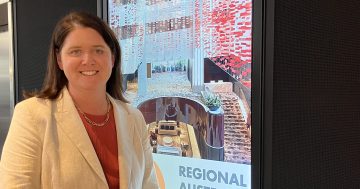
Bermagui in Bega Valley Shire. The shire is attracting strong net inflows of people. Photo: David Rogers Photography.
The Bega Valley and Eurobodalla shires experienced Australia’s fastest annual percentage growth rate in net internal migration in the year to 30 June.
The data appeared in the latest edition of the Regional Movers Index, developed by the Regional Australia Institute in partnership with the Commonwealth Bank of Australia. It is based on the bank’s data of relocations of its 16 million customers.
The index provides quarterly updates on the trends identified in the institute’s Big Movers report of 2019 that found in recent decades the number of people moving from Australia’s capital cities to regional areas exceeds the number moving from regional areas to capital cities.
The index refers to this as internal migration, namely, the movement of people within Australia.
Across Australia, in the 12 months to 30 June, people moving from capital cities to regional areas accounted for 11.2 per cent of all internal migration. In contrast, people relocating from regional Australia to capital cities accounted for 8.8 per cent.
For context, the lion’s share of internal migration – 67.4 per cent – was people moving between capital cities. The report said that regional people tended to stay in regions, and that “housing and cost of living pressures are continuing to influence the patterns of movement within Australia”.
According to the index the population flow from capital cities to regional Australia is consistent with the levels seen during COVID and is 16.4 per cent above the pre-pandemic average. The index goes back to March 2016.
The index identified the five fastest growing regions or growth ‘hot spots’ as measured by annual growth in net internal migration.
These included Strathbogie and Surf Coast local government areas (LGA) in Victoria and Northam in Western Australia. Topping the list though were the Bega Valley and Eurobodalla shires.
Both Far South Coast shires recorded annual growth in net internal migration inflows in the 12 months to 30 June of more than 300 per cent from the 12 months to 30 June 2023. The big percentage increases likely reflect a low base in the year to June 2023 for comparison.
The report said the index’s methodology was designed to filter out significant outlier results associated with changes in small numbers. It said significant outlier growth rates were not published or ranked.
To be listed in the index and considered for the top five rankings, an LGA must have had net internal migration inflows in 2024 of 50 or more people and had a base of net internal migration, net capital-to-region or net region-to-region inflows of more than 10 people.
A double-check against the 2021 ABS census data validated the point that the Far South Coast population is growing strongly. For example, Bermagui’s population of 1798 was up 21.4 per cent from 1481 in 2016.
The index noted while the Bega Valley was very popular with people moving from cities, Eurobodalla’s population increase was due to inflows from other LGAs outside of capital cities.
Across Australia the five fastest growing LGAs in each state and territory tended to be outside of commuting distance to cities, “with movers increasingly attracted to areas with thriving local economies built on industries such as mining, agriculture, manufacturing, healthcare and tourism”.
“The availability and cost of housing are also influencing this broader movement pattern, as movers seek regions where house price growth is slowing or there is some rental availability,” the report said.
The report demonstrates the need for the supply of housing, healthcare, educational facilities, and infrastructure, to keep pace with the shires’ growing populations.
Original Article published by Marion Williams on About Regional.





















